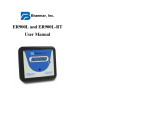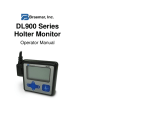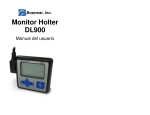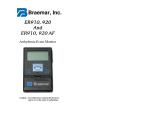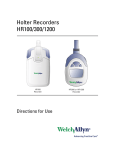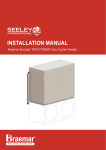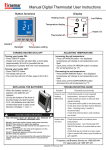Download Braemar DL700 Specifications
Transcript
Braemar, Inc. DL700 Operator Manual Caution: U.S. Federal law restricts this device to sale by or on the order of a physician. Braemar Limited Warranty Braemar products are warranted to be free from manufacturing and material defects for a period of one (1) year from the date of shipment from Braemar to the original purchaser. Excluded from this warranty are expendable supply items including, but not limited to, electrodes, leadwires, patient cables and batteries. This warranty does not apply to any product that Braemar determines has been modified or damaged by the customer. Except for the express warranties stated above, Braemar disclaims all warranties including implied warranties of merchantability and fitness. The stated express warranties are in lieu of all obligations of liabilities on the part of Braemar for damages, including but not limited to, special indirect or consequential, arising out of or in connection with the use or performance of Braemar products. Any action for breach of warranty shall be commenced within one (1) year of said breach or be forever barred. Any repairs made to the product that are not covered by the warranty shall be billed to the customer. Document Number: 600-0573-00 Revision: G Date: March 2006 i ii Table of Contents Product Overview .............................................................................................. 1 1. Description................................................................................................... 2 2. Specifications............................................................................................... 5 Product Operation ............................................................................................. 7 3. Recorder Preparation ................................................................................... 8 3.1 Battery Installation ................................................................................ 8 3.2 Setting the Clock .................................................................................... 8 4. Electrode Application ................................................................................ 10 4.1 Materials Needed ................................................................................. 10 4.2 Recommended Steps............................................................................. 10 5. Operation .................................................................................................. 12 5.1 Materials Needed ................................................................................. 12 5.2 To Start Recording............................................................................... 12 5.3 To Stop Recording ............................................................................... 14 5.4 Analyzing the ECG Data...................................................................... 14 Service And Maintenance................................................................................ 15 6. Maintenance............................................................................................... 16 6.1 Replacing the Clock Battery ................................................................ 16 7. Troubleshooting Guide .............................................................................. 18 7.1 Problem Description and Recommended Solution .............................. 18 8. Service Items.............................................................................................. 20 Appendix A ....................................................................................................... 21 9. Electrode Placement (7 Lead) .................................................................... 22 10. Electrode Placement (5 Lead) .................................................................. 24 iii iv DL700 Holter Monitor DL700 Holter Monitor 1. Description Product Overview The DL700 Holter Recorder is a battery operated solid state recorder designed for 24 hour continuous recording of ambulatory ECG data. It is an AAMI Type I device, which is part of a conventional AECG monitoring system where the ECG is recorded on a removable Flash memory card in the DL700. After the ECG data has been recorded, the memory card is removed from the DL700 and inserted in a Flash Card Reader which is part of the Computer Analysis System on which the ECG will finally be analyzed. The Flash memory card used in the DL700 is the same as some PCMCIA memory cards used in laptop computers. Batteries and Receptacle The DL700 provides a battery compartment with secure receptacles for inserting two standard AA alkaline batteries. A polarity guard feature is built in to prevent damage in case the batteries are installed incorrectly. Cover Labeling The label on the outside of the cover provides information about the company supplying the recorder while the label on the inside of the cover provides Patient Hook-up and Recording Start/Stop instructional information. Digital Clock A digital LCD clock is mounted into the front panel to provide both time and date for patient convenience. Clock Battery The digital clock is powered by a Duracell silver oxide 392B, 1.5V battery or its equivalent. For instructions on battery replacement, refer to the Maintenance Section. Clock Set Controls The clock set controls are used to set the date and time. Time can be set in hours and minutes. 1 2 DL700 Holter Monitor DL700 Holter Monitor Patient Event Button Gain Switch Patients should be instructed to use this Event Button anytime they feel symptoms similar to those which they have been instructed by their physician to note in their Patient Log along with date and time information. A gain switch is provided to allow the medical technician to adjust signal amplitude. Three positions are provided: 1/2X, 1X, and 2X. Position indications are on the label above the switch. Operating LED This is the green LED just to the right of the gain switch (Fig 1). It provides current status information on the recorder (See Operation Section). Equipment Symbols Symbol Description Type B equipment. Consult manual. 0086 Complies with the Medical Device Directive of the European Union. Waste Electrical and Electronic Equipment (WEEE) It is the responsibility of the end user to dispose of this equipment at a designated collection point for recycling. Figure 1 DL700 Holter Recorder Year of Manufacture Patient Input Connector The patient input connector provides a snug and reliable connection for the patient electrode leads along with complete color-coding for each lead. SN REF Serial Number Not shown - DL700 is the catalogue number. Test Jacks Three test jacks are provided to verify that a good, reliable signal is being obtained on each ECG channel immediately after connecting the electrodes to the patient. This test should be done prior to allowing the patient to leave the clinic. 3 European Representative: CEpartner4U BV Esdoornlaan 13 3951 DB Maarn. The Netherlands Tel: +31 (0) 6-516.536.26 4 DL700 Holter Monitor DL700 Holter Monitor 2. Specifications Functional Channels Resolution Recording Minimum Recording Time Storage Medium : : : : : Download Interface 3 8-bit Full disclosure 24 hours Removable FLASH memory (Standard PCMCIA-ATA card) : PCMCIA card interface Physical Dimensions Weight Enclosure Operating Position Operating Temperature Non-operating Temperature Operating Humidity : : : : : : : 6.00" x 3.50" x .95" 10 ounces with batteries Molded plastic Any orientation 0 C to 45 C -40 C to 60 C 10% to 90% (non-condensing) Electrical Gain Settings: 1/2X, 1X, and 2X Battery : Two AA Alkaline (disposable) Connector : 7 pin (3 diff + 1 com), single lead wires Test Jacks : 3 channels 5 6 DL700 Holter Monitor DL700 Holter Monitor 3. Recorder Preparation Product Operation 3.1 Battery Installation To ensure a full 24 hour recording it is essential to use new batteries before each patient recording. The recommended batteries for the DL700 Holter recorder are two AA alkaline batteries (IEC-LR6). When inserting the batteries, follow the Start Recording procedure in the Operation section while making sure to follow the polarity indication shown on the label in the battery compartment. - Note There is a built-in polarity guard feature to protect against damage to the recorder but if the batteries are installed improperly, the unit WILL NOT RECORD and the LED WILL NOT BLINK. 3.2 Setting the Clock Time and Date on the digital clock can easily be set by the following procedure using the two small access holes labeled "set" and "select". The holes are located next to the Patient Event Button shown in Figure 1. a) Insert and press a pointed object into the top access hole, labeled "set", to start the setting process. b) Press the pointed object into the bottom access hole, labeled "select". The digital display alternately shows the time and date. c) Press the bottom access hole a second time to select MONTH. - Note Pressing the bottom access hole repeatedly, cycles the digital clock through each selection - Month, Date, Hour, Minutes. d) To set the current month, press the top access hole repeatedly to obtain the desired month. e) 7 8 Press the bottom access hole again to select DATE. DL700 Holter Monitor f) To set the current date, press the top access hole repeatedly to obtain the desired date. DL700 Holter Monitor 4. Electrode Application g) Press the bottom access hole to select the HOURS. For safe and effective use, it is recommended that application of electrodes be handled by trained medical personnel. h) Press the top access hole repeatedly to set the correct hour in A.M. or P.M. i) Press the bottom access hole to select MINUTES. j) Once again, press the top access hole repeatedly to set the correct number of minutes. Proper preparation of the patient's skin is absolutely essential to obtaining a quality ECG recording. - Note Without good skin preparation, both noise and artifact will frequently degrade the patient’s ECG to the point of being unusable by the physician. k) Press the bottom access hole to display the correct time. 4.1 Materials Needed - Note If it is desired to have the Date and Time flash alternately - press the bottom access hole after completing the previous step. Then, press the lower access hole 5 times to set the colon flashing. a) For 3 channel recording, use seven (7) Silver-Silver chloride disposable pre-jelled electrodes designed for 24 hour Holter monitoring. Do not use 12-lead ECG or Stress Test Electrodes. Use electrodes designed for longer term 24 hour monitoring. b) 4 X 4 Prep Pads c) Isopropyl alcohol 4.2 Recommended Steps a) Select the sites for electrode application. The electrodes must be applied over bone or cartilage. Refer to the Electrode Placement Chart sections in Appendix A. b) Wipe the skin in the electrode areas with an alcohol prep pad. c) After allowing the skin to dry thoroughly, locate the electrode placement sites by palpation. d) Dry shave body hair from the electrode sites. e) 9 10 Using a small square piece of an abrasive material (220 grit sandpaper or equivalent) and moderate pressure, abrade the skin at the electrode sites by making 3 or 4 crossing strokes. The strokes should cross at the chosen electrode site. Lightly brush the areas with a dry gauze pad to DL700 Holter Monitor DL700 Holter Monitor remove any debris. f) 5. Operation Connect the color coded snap-on lead wires to the appropriate electrodes before applying the electrodes to the patient. 5.1 Materials Needed g) Once the backing is removed from each electrode, place it firmly on the prepared skin surface site. a) h) In order to prevent the lead from tugging directly on the electrodes, create a strain relief by looping each lead wire and placing a strip of adhesive tape over the loop as well as on the electrode. b) Two AA Alkaline (IEC-LR6) batteries. c) One Flash memory card with a storage capacity of 10 MB or larger. The card requires no special formatting prior to its first use. Patient Diary. d) Recorder, either 5 or 7 lead patient cable, pouch or carrying case, shoulder strap and belt. 5.2 To Start Recording a) Enter the patient’s personal data on the Flash memory card label including the doctor's name, patient's name, and the date and start time of the test. (A Sharpie, fine point, erasable marking pen is recommended). This information should also be noted in the patient's diary and the patient should then be instructed on how to fill out this diary. - Note Since the flash memory card is intended to be reused, the patient label on the back side of the card has been designed to be easily erased so that the next patient’s data can be written in the same area. Insure use of an erasable marker. b) Insert the Flash memory card into the recorder. c) The electrodes and lead wires should be attached to the patient as specified in the previous section (Electrode Attachment). Once this has been done, the lead wires must next be connected to the recorder carefully following the color code above the input connector. d) Install two fresh alkaline AA batteries. - Caution All previous ECG patient data on the Memory card will be erased immediately once the new batteries are inserted. 11 12 DL700 Holter Monitor e) The green operating LED will start to blink at a steady rate to indicate normal operation. The LED will blink at this rate for up to 15 minutes allowing time to verify that the signal on each channel is acceptable. After this startup interval, the LED will begin blinking at a slower rate to indicate that ECG recording has begun. The final blink rate will vary somewhat depending on the storage capacity of the flash card and the patient signal characteristics. DL700 Holter Monitor 5.3 To Stop Recording a) - Warning DO NOT RE-INSERT BATTERIES after removal as this will erase the ECG data on the Flash memory card. - Warning If the LED is NOT BLINKING after the previous step, the unit is NOT RECORDING. This LED is the only indicator that the recorder is functioning properly and it should always be blinking whenever the unit is recording. If it is not, please see the Troubleshooting Guide section. f) To insure that a good quality patient hookup has been achieved, a test ECG output strip can be run on an ECG machine. To run a test strip, connect a standard Test Box to the 3 recorder test jacks shown in Figure 1. Insert the plugs from the ECG machine into the Test Box. Run a test output strip. Verify that there is an acceptable signal on each channel. It may be necessary to adjust the gain by using the recorder gain switch located next to the green LED shown in Figure 1. After selecting the final gain setting, disconnect the Test Box from the recorder. b) Remove the Flash memory card and patient electrodes. If it is desirable to remove the leads from the patient input connector, then, due to their snugness of fit in this connector, it is suggested that the medical technician carefully grip these leads only at the base whenever removing them. NEVER pull on the wire itself as this can easily break the wire inside the insulation causing a noisy and intermittent ECG recording. 5.4 Analyzing the ECG Data a) g) To abort the standard 15 minute startup interval once the preparation is complete and it is desired to start the ECG recording, hold the event pushbutton in until the LED stops blinking (usually about 5 seconds). Release the pushbutton and the LED will start blinking at a slower rate, as described in Step e) above. c) Once the data transfer is complete, the previous patient’s name and any other information written on the Flash memory card’s label should be removed and the ECG data should be erased. d) The Flash memory card is now free to be used for the next patient. If there is a need to stop the recorder after the recording session has begun, please refer to the following section “To Stop Recording”. 13 Insert the Flash memory card into the Flash card reader of the Computer Analysis System on which the ECG analysis is to be performed. b) The Computer Analysis System must have special download software installed to transfer the ambulatory ECG data from the Flash memory card to the Analysis System. h) Close the top cover of the recorder, place the recorder in the pouch, and attach the recorder to the patient utilizing either the belt or the shoulder strap. Caution the patient to avoid getting the recorder wet and to NOT pull on the electrodes. i) To stop recording after 24 hours, or sooner if desired, remove the batteries completely. 14 DL700 Holter Monitor DL700 Holter Monitor 6. Maintenance Service And Maintenance The DL700 Holter Recorder requires virtually no maintenance. Ensure that the battery contacts are clean and that the inside of the recorder is free of dust and dirt. The case and the pouch with belt and strap can be cleaned with a lint free towel moistened with mild soap and water. Do not use any strong solvents. Clean as often as desired. 6.1 Replacing the Clock Battery The digital clock uses one 1.5V silver oxide battery (Duracell 392B or its equivalent). The battery has approximately a two year life. The battery is accessed under the top cover. a) Open the top cover. Use a small jeweler's screwdriver inserted into the exposed center screw on the back of the clock module to gently lift the clock out of the endcap. Figure 2 Removing Clock b) Using the jeweler's screwdriver, remove the top small screw in the metal holder that keeps the battery in place. c) 15 16 Loosen the other screw holding the metal holder. Swing the metal holder to the side. DL700 Holter Monitor DL700 Holter Monitor 7. Troubleshooting Guide If there is a problem with the recorder, first review the “Typical Problem Descriptions and Recommended Solutions” listed below. If assistance is needed, call the following number for customer support and/or arrangements for service of the recorder: Braemar, Inc. Figure 3 Replacing Clock Battery 1285 Corporate Center Drive, Suite 150 Eagan, MN 55121 USA Phone: 800.328.2719 Fax: 651.286.8630 E-mail: [email protected] Web: http://www.braemarinc.com d) Remove the used battery and dispose of it properly. e) Position the new battery in place with the + side facing the direction as shown in Figure 3. f) Reposition the metal holder and reinstall the first screw. Tighten the two screws. Re-insert the clock module into the recorder. 7.1 Problem Description and Recommended Solution Problem: Green LED is not blinking. Solution: - Ensure that a Flash Memory card of at least 10 MB capacity has been properly inserted in the recorder. - Install a new set of AA alkaline batteries which are known to be fully charged. New batteries MUST be used for each Holter recording. - Verify that the batteries are oriented according to the label in the bottom of the battery compartment. - Reinitialize by lifting one of the AA batteries for several seconds and then re-inserting. g) Reset the time and date. Refer to the Operations section of this manual for information on setting the clock. Problem: Digital clock is blank Solution: Replace clock battery by referring to the Maintenance section in this manual. - Note The digital clock is independent from the operation of the DL700 and does not affect the recording. 17 18 DL700 Holter Monitor Problem: Noisy ECG Recording Solution: - Ensure that all the electrodes are firmly and securely attached to the patient. (Refer to “Electrode Attachment” section). - Replace the entire lead set. (These leads are frequently broken inside the lead insulation due to someone pulling on the leadwire instead of at the base of the lead to remove it from the patient input connector). 19 DL700 Holter Monitor 8. Service Items Part Number 1 HeartStor card, 16 Mbytes 350-0147-01 2 HeartStor card, 32 Mbytes 350-0147-02 3 HeartStor card, 64 Mbytes 350-0147-03 4 Digital clock module 800-0364-01 5 Lead set, patient, 7 lead 200-1380-001 6 Lead set, patient, 5 lead 200-1380-002 7 ECG Test cable box 200-1588-001 8 Pouch with strap and belt 200-1508-001 9 Filler plugs 200-1586-001 10 Shoulder strap, pouch 100-1693-001 11 Belt strap, pouch 100-1694-001 20 DL700 Holter Monitor DL700 Holter Monitor Appendix A 9. Electrode Placement (7 Lead) Seven color coded leadwires are utilized to create a 3 channel ECG recording. 3 Channel Electrode Placement Chart: White: Channel 1 (-); Place on the right Manubrial border of the Sternum. Red: Channel 1 (+); Place on the left Anterior Axillary line 6th rib. Black: Channel 2 (-); Place on the left Manubrial border of the Sternum. Brown: Channel 2 (+); Place at approximately 1 inch right of the Xiphoid Process on the rib. Blue: Channel 3 (-); Place on the Center of the Manubrium. Orange: Channel 3 (+); Place on the left Mid-Clavicular line 6th rib. Green: Ground; Place on the lower right rib margin over bone. Channel Designation Channel 1: White - Red Channel 2: Black - Brown Channel 3: Blue - Orange 21 22 DL700 Holter Monitor DL700 Holter Monitor 10. Electrode Placement (5 Lead) Five color coded leadwires are utilized to create a 2 channel ECG recording. 2 Channel Electrode Placement Chart: White: Channel 1 (-); Place on the right Manubrial border of the Sternum. Red: Channel 1 (+); Place on the left Anterior Axillary line 6th rib. Black: Channel 2 (-); Place on the left Manubrial border of the Sternum. Brown: Channel 2 (+); Place at approximately 1 inch right of the Xiphoid Process on the rib. Green: Ground; Place on the lower right rib margin over bone. Channel Designation Channel 1: White - Red Channel 2: Black - Brown Figure 4 7 Lead Electrode Placement 23 24 DL700 Holter Monitor Figure 5 5 Lead Electrode Placement Braemar Inc. Phone: 800.328.2719 1285 Corporate Center Drive, Suite 150 Fax: 651.286.8630 Eagan, MN 55121 USA E-Mail: [email protected] Copyright 2006, Braemar Inc. All rights reserved 25


















